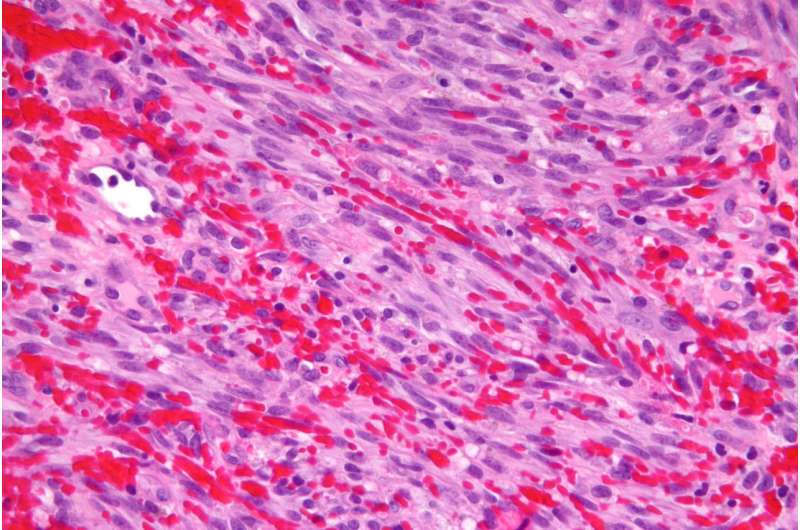Study describes structure of herpes virus linked to Kaposi's sarcoma

UCLA researchers have provided the first description of the structure of the herpes virus associated with Kaposi's sarcoma, a type of cancer.
The discovery answers important questions about how the virus spreads and provides a potential roadmap for the development of antiviral drugs to combat both that virus and the more common Epstein-Barr virus, which is present in more than 90 percent of the adult population and is believed to have a nearly identical structure.
In the study, published in the journal Nature, the UCLA team showed in the laboratory that an inhibitor could be developed to break down the herpes virus. Kaposi's sarcoma-associated herpes virus, or KSHV, is one of two viruses known to cause cancer in humans.
There are eight human herpes viruses, and they cause a wide spectrum of diseases, ranging from common cold sores to cancer. Most people carry one or more of the viruses. The herpes virus typically does not cause major health problems until the immune system is compromised—after an organ transplant, by AIDS or another disease that affects the immune system, or in older age.
KSHV was discovered in the mid-1990s at the height of the AIDS epidemic, when as many as half of people with AIDS were found to have the virus; it continues to be the most common cancer-causing virus associated with AIDS. In low-income countries, KSHV also poses a significant threat to people who don't have AIDS. In sub-Saharan Africa, for example, approximately 40 percent carry the virus, and Kaposi's sarcoma is among the most common cancers in the region.
No vaccine or drug has been developed to prevent or treat KSHV or the cancer it causes; nor has a vaccine or treatment been developed for Epstein-Barr, another member of the herpes virus family and one of the most common viruses in humans. Epstein-Barr is best known for causing infectious mononucleosis, but it is also associated with an increased risk for several cancers, as well as a rare type of head and neck cancer called nasopharyngeal carcinoma.
Knowing the atomic structure of the herpes virus's protein shell, or capsid, could be an important step toward antiviral therapies. It would give scientists specific targets in the protein shell that are critical to the virus' ability to spread.
Without that atomic description, "it was impossible to determine how the genome was being sustained through the spread of the virus," said Z. Hong Zhou, a professor of microbiology, immunology and molecular genetics, a member of UCLA's California NanoSystems Institute, and a senior author of the research. "Our study provides that atomic description."
The UCLA researchers used a new electron-counting technology called cryo-electron microscopy, whose inventors won the 2017 Nobel Prize in chemistry. The technology enabled the scientists to see the herpes virus with unprecedented resolution, which in turn allowed them to create a 3-D atomic model of the virus. The virus is composed of approximately 3,000 proteins, each consisting of roughly 1,000 amino acids.
"The high pressure caused by the densely packed herpes virus genome also means that if one unit is weakened, the whole structure will fall apart," said Ren Sun, a professor of molecular and medical pharmacology, and bioengineering, a member of the California NanoSystems Institute and the study's co-senior author. "This offers a distinct advantage as a mechanism for drug development."
Sun's group is following up on these findings by screening for drugs that could perform similar antiviral actions in humans.
More information: Xinghong Dai et al, Structure and mutagenesis reveal essential capsid protein interactions for KSHV replication, Nature (2018). DOI: 10.1038/nature25438
Journal information: Nature
Provided by University of California, Los Angeles


















